

Abortion Rights Around the World in 7 Maps
source link: https://medium.com/@Jeroen001/abortion-rights-around-the-world-in-7-maps-35f03b72476d
Go to the source link to view the article. You can view the picture content, updated content and better typesetting reading experience. If the link is broken, please click the button below to view the snapshot at that time.
Abortion Rights Around the World in 7 Maps
Trigger warning: Rape
I don’t need to explain what event made me write this, do I? As my first post here, I just want to look into how abortion rights differ between countries and regions. A lot of people outside of the US are also very angry about the Supreme Court ruling, with many seemingly unaware of the legislation in their own country. To help clear that up, I made some maps about it.
I decided to do this as some very quick googling made me stumble upon the Wikipedia map below. It’s very messy, has too many colours and tries to portray too much different information at once. Some of the categories show on the map can also be considered subcategories. There’s no legend in the image below, but I don’t think that’s a problem as the maps below this one will show the same information more clearly. If you want to see the legend anyway, you can look it up using the source yourself. Either way, I didn’t like the map and felt like making my own.
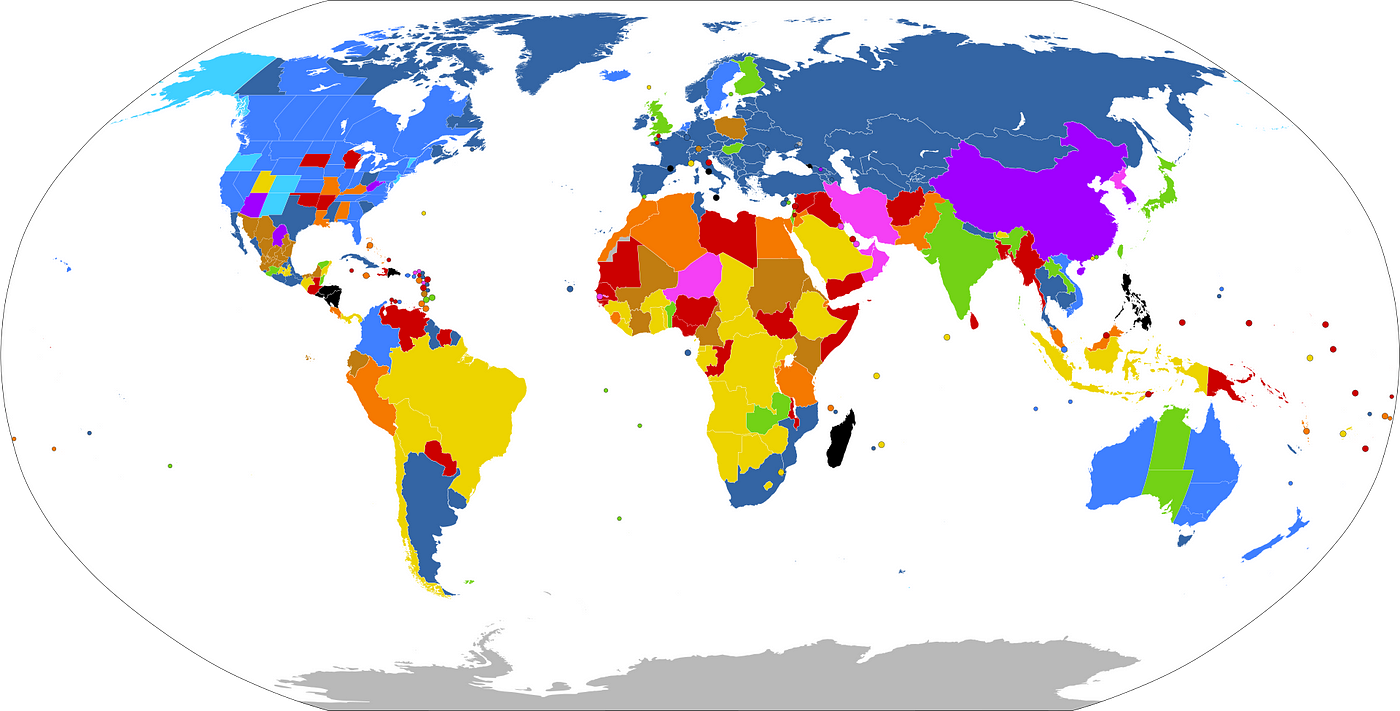
Source: By Original by NuclearVacuum, modified by Heitordp — References in Abortion law. Map shape based on File:World map configurable.svg., CC BY-SA 3.0, https://commons.wikimedia.org/w/index.php?curid=8647323
Before I continue, let me stress that I didn’t do any data research for this. I’m just using the data that is compiled in a huge table on this Wikipedia page as it was on June 28th 2022. I’m also not looking to go into the rights or wrongs of abortion or how it should be legislated. I just wanted to make some maps. It would also be interesting to look at how the strictness of abortion legislation correlates with other demographic or geographic variables, but that goes outside the scope of this blogpost. Maybe something for another time.
In an attempt to be transparent about what I do, I will share all my sources and code as well as steps to produce them in detail at the bottom of the page. This as a transparency measure and to enable feedback on my thought processes so they can be improved. If you just want to see some cool maps tho, you don’t need to scroll far.
Risk of Life
Let’s start with a rather general overview map of the data on abortion legality when the life of the mother is at risk. You can make the map bigger by clicking on it.
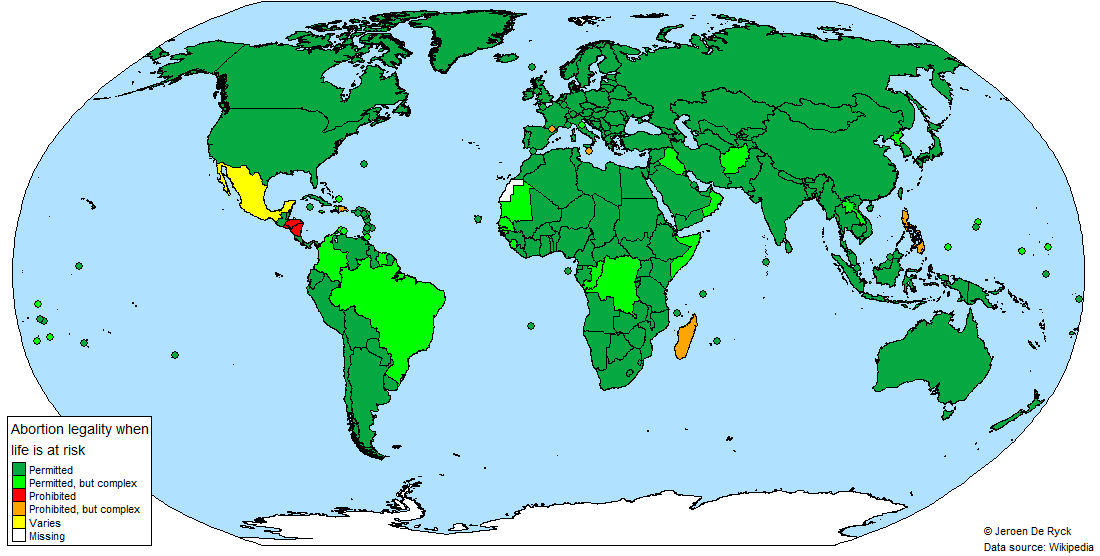
World map of the legality of abortion if the life of the mother is at risk
In the large majority of countries and regions included here (223/252 ≈ 88%) abortion is legal when the life of the mother is at risk. When we only look at countries, There are only nine countries where there is not the case. Abortion in this scenario is completely illegal in only three countries: Honduras, El Salvador and Nicaragua. Interestingly enough, these countries neighbour each other.
There a further five countries that prohibit abortion in this scenario, but where the application of the law is more complex. These countries are Andorra, the Dominican Republic, Madagascar, Malta and the Philippines. These countries differ wildly when it comes to many other statistics: Malta and Andorra are very highly developed, where Madagascar is the complete opposite and the Dominican Republic, the Philippines and the countries in Latin-America are somewhere in between. We’ll come back to that later.
Finally, some context about Mexico: all subdivisions allow abortion in this scenario, except for Querétaro and Guanajuato. These also fall in the category of “Prohibited, but complex”. Let’s continue and look at abortion legislation when the health, but not the life, of the mother is at risk. I unfortunately could not find a clearer defintion on what the “health of the mother” means. Presumably it differs per country or region.
Risk of Health
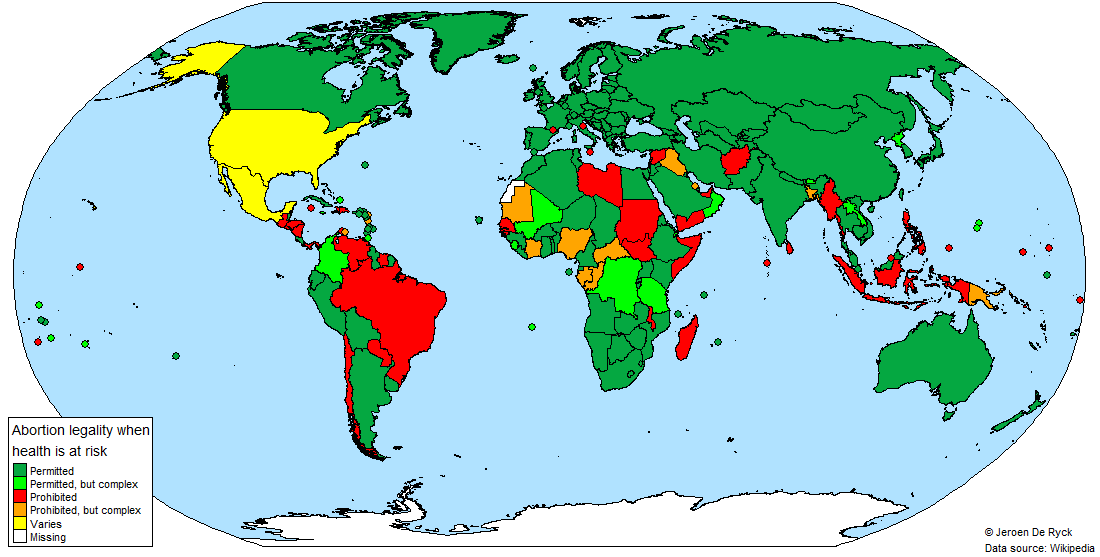
World map of the legality of abortion if the health of the mother is at risk
Suddenly, our map looks a whole lot more red. We can see that South America is very polarized in this scenario. Seven countries have it simply permitted whilst six others have it prohibited. Two countries do permit it, but with complexities: Trinidad and Tobago and Colombia. Africa is also quite divided, but with complex legislation or application. The same can be said about the Indo-Pacific Region.
Europe is more coherent, with only three countries not fully permitting abortion when the health of the mother is at risk. These countries are Andorra, Malta and San Marino. These three were also the only ones not to simply allow abortion when the life of the mother is at risk, although San Marino was classified as “Permitted, but complex” there.
Let’s talk some more about numbers. 137 out of 196 countries (≈70% allow abortion, whereas 28% don’t allow it. In 2 countries, the U.S. and Mexico, rules differ by subdivision (as it’s way complexer, we won’t get into it).
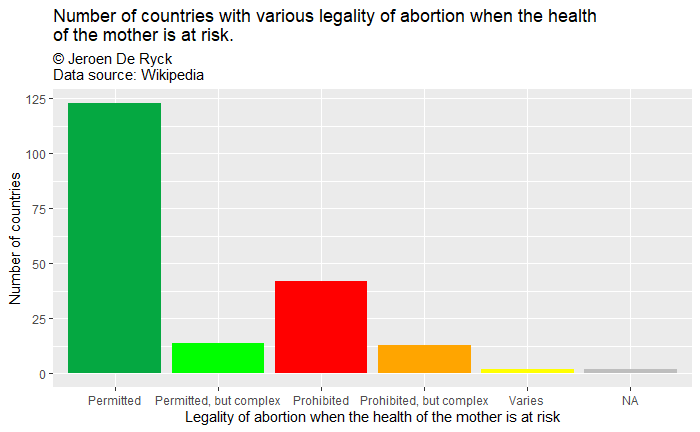
The next scenario looks at the legality of abortion when the pregnancy was caused by rape. What constitutes rape and in which such cases abortion is allowed also differs per country. But let’s look at the map first, which is getting even more red.
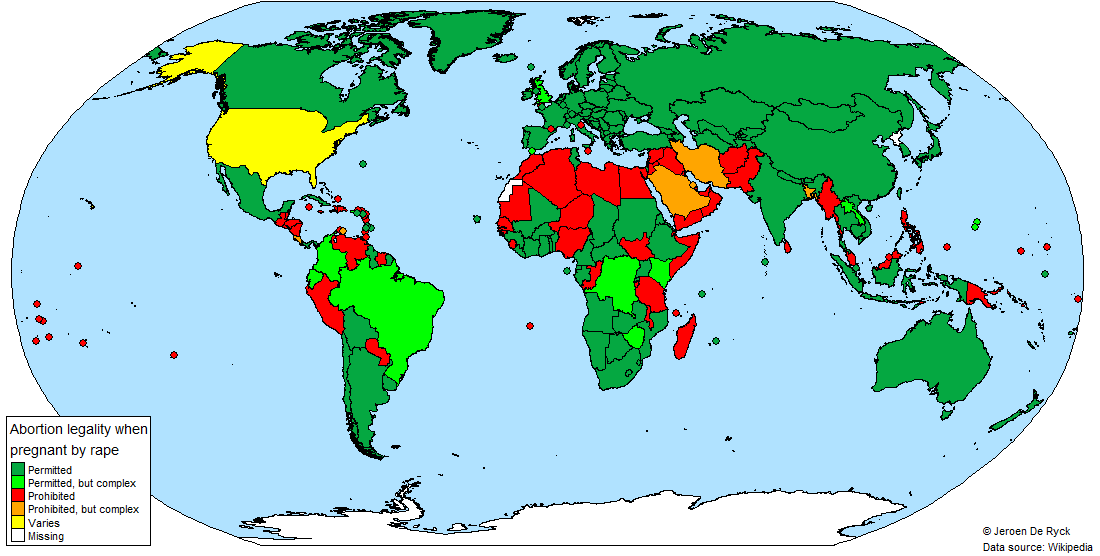
World map of the legality of abortion if the pregnancy was caused by rape
There are several things that stand out here. First of all, it looks like South America is way more liberal when the pregnancy is caused by rape than when the mother is at risk of health issues than the rest of the world. However when looking at absolute numbers, and not distortions due to country sizes (looking at you Brazil) it’s not that spectacular. Only three countries that prohibit abortion in the previous scenario (risk of health) allow it in the current (rape). Only two countries to the reverse. Five countries have ‘flipped’, if you will of the 14 in total. A good example of how you can create false impressions with maps.
Something else that stands out is the Arab World. It has completely prohibited abortion when the mother was raped, with the notable exceptions of Tunisia and South Sudan. It’s easy to think that this has something to do with religion, but several other muslim-majority countries do permit abortion when the mother was raped such as Indonesia, the Balkan region in Europe and Central Asia.
A minor thing that grabbed my attention anyway was the Pacific Island Nations and overseas territories. A clear majority has prohibited abortion when the mother was raped.
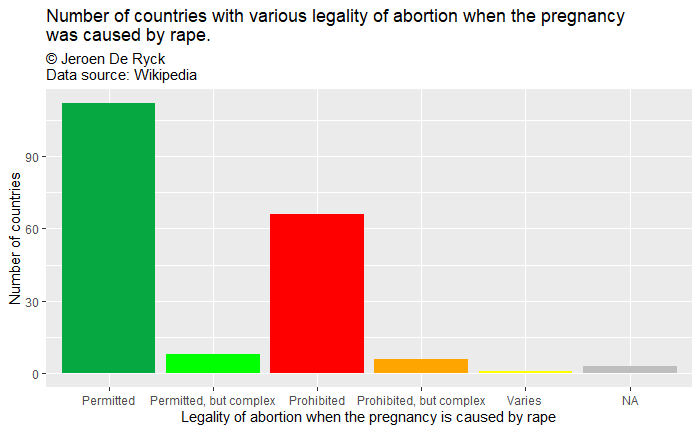
Number of countries with various legality of abortion when the pregnancy was caused by rape.
When looking at absolute numbers, we can see that there are still more countries that allow abortion then not when the pregnancy is caused by rape. The only country where rules vary is the US. Mexico this time is united in its legislation. Something that also stands out from these graphs is that only a minority of countries have complex legislation. In the very large majority, legislation is clear: abortion is permitted or prohibited.
Fetal Impairment
Another reason a mother may choose to terminate a pregnancy, is that there will be (severe) birth defects that are known about during the pregnancy. These can be caused by genetics, but also certain diseases or intoxication and even the age of the mother.
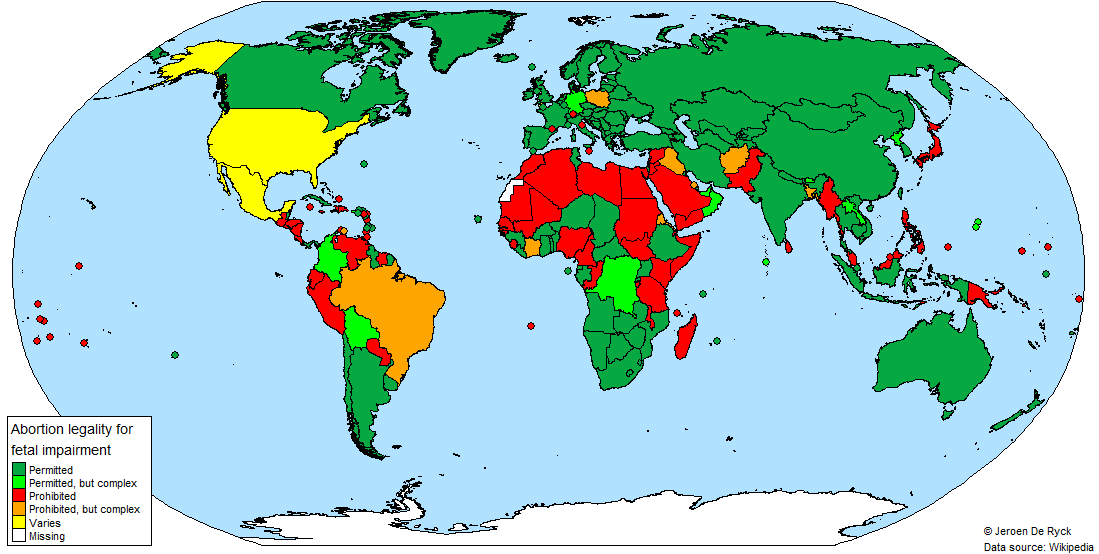
World map of the legality of abortion for fetal impairment
The map remains very similar to the previous one. This in itself is interesting. Many countries who don’t allow abortion when the mother is raped also don’t allow abortion when there will be birth defects. Despite the big similarities, there are a tad more red and orange countries here. Let’s look at the absolute numbers for that.
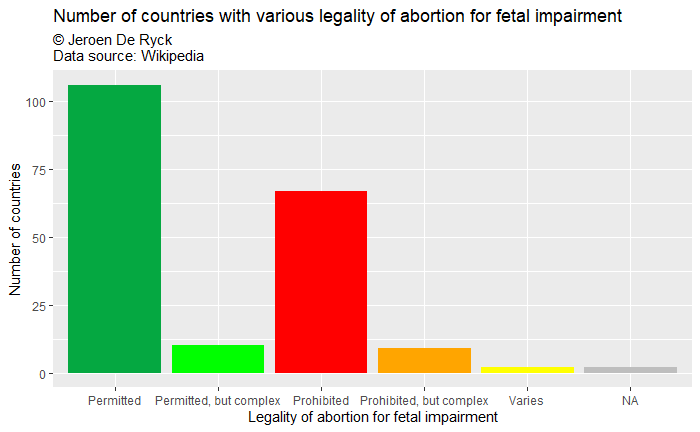
Number of countries with various legality of abortion for fetal impairment
116 countries allow abortion when it is known there will be birth defects. That’s just short of 60%. And whilst we have been talking a lot about these numbers, it should be noted that this is just the number of countries. It would also be interesting to look at other statistics, like number of women.
One noteworthy place in this category is Guernsey, a small island in the Channel. Although technically it is called the Bailiwick of Guernsey as it also contains other islands. It’s separated into three subdivisions two of which prohibit and one allows abortion for fetal impairment.
Socioeconomics reasons
Having children costs a lot of money and takes a lot of time. People’s financial situation may change very quickly in both the positive and negative way, which may impact someone’s wish of having children. Some countries therefore allow abortion for socioeconomic reasons. Let’s look at the map to figure out which ones.
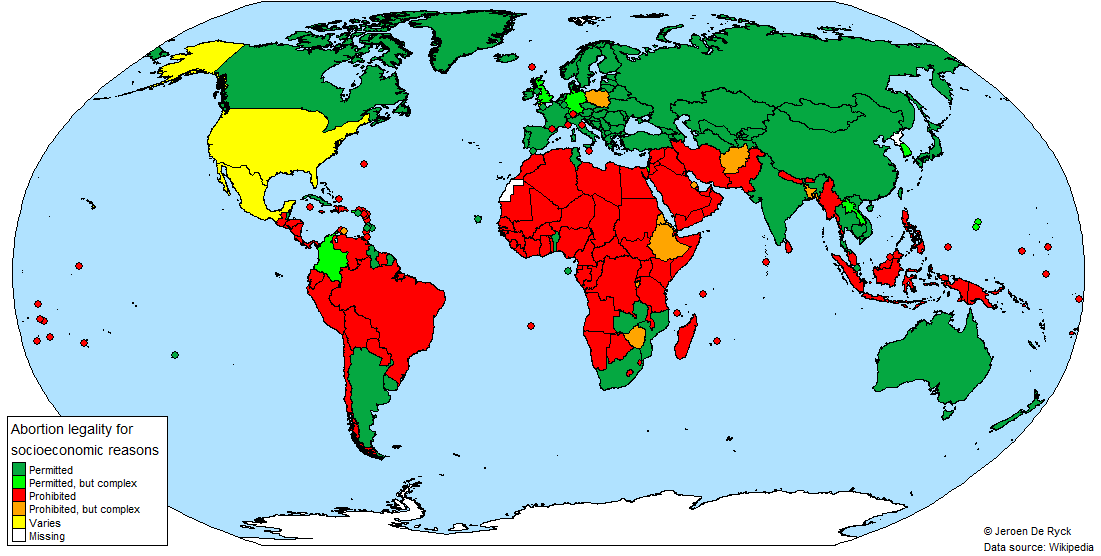
World map of the legality of abortion for socioeconomic reasons
What immediately stands out is the homogeneity of regions. Almost all of Africa and the Middle East have completely prohibited abortion for socioeconomic reasons. This stand in stark contrast to Europe, which, bar the micro-nations and Poland, does allow this. Most of Asia does as well.
The micro-nations in Europe aren’t the only ones that stand out. Almost all Pacific Island Nations also prohibit abortion for socioeconomic reasons. I cannot think of a single reason why this might be. If you have any clues, let me know in the comments.
Lastly, Guernsey is a special case here too. Just like in the previous scenario, the same two subdivisions (Alderney and Sark, by the way) prohibit it, whilst the main island of Guernsey does allow it.

Number of countries with various legality of abortion for socioeconomic reasons
For the first time, the number of countries that prohibit (113) abortion in a scenario is larger than the number of countries that allow it (78) .
On request
Probably the most talked about scenario these days is abortion on request. Someone might want an abortion for an accidental pregnancy. Having the possibilty to terminate a pregnancy when the mother wishes to do so, regardless of the reason, is something that is considered important by many women’s rights activists. They’re certainly not wasting their time as the map is redder then we’ve seen it so far.
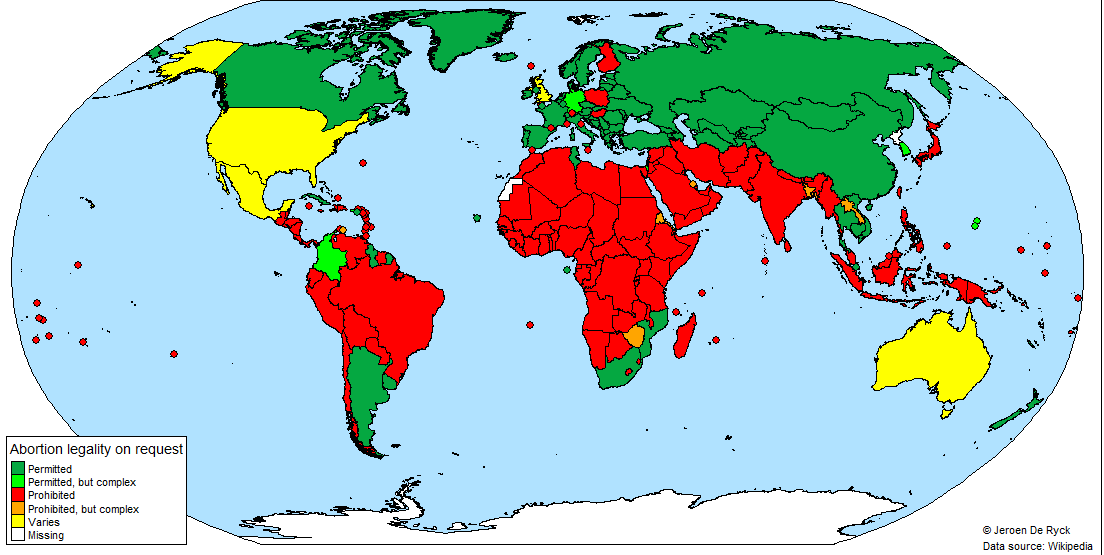
World map of legality of abortion on request
But it’s only slightly redder than the previous one. Not a single country allows abortion on request, but not for socioeconomic reasons. Some notable examples of the opposite are India, Finland, Poland, Japan but also the Northern Territory in Australia, which is the only subdivision to completely prohibit abortion in any scenario regardless of gestational age in the country. Our friend Guernsey, however, is united in the prohibition of it.
The United Kingdom is also internally divided on this issue. Northern Ireland is the only part of the UK that allows abortion on request up to a gestational age of 12 weeks since 2020. Scotland, Wales and England all prohibit abortion on request completely.
Abortion Freedom Index
Finally, I wanted to make a summary of all these maps and combine the data into one. Now, this is just a blogpost, not a scientific article, so what I’m about to do here is just to get an idea of abortion liberty across the world. For every scenario above a country allows abortion (even if it’s complex), it gets a point. The index therefore indicates the amount of situations in which someone is able to get an abortion. I’m not taking into count gestational age limits, because this data is only available for a limited number of countries. I’ve called the total number of points the Abortion Freedom Index, which apparently didn’t exist until now. Countries that vary in more than one scenario are left out of the index. Here’s the result:
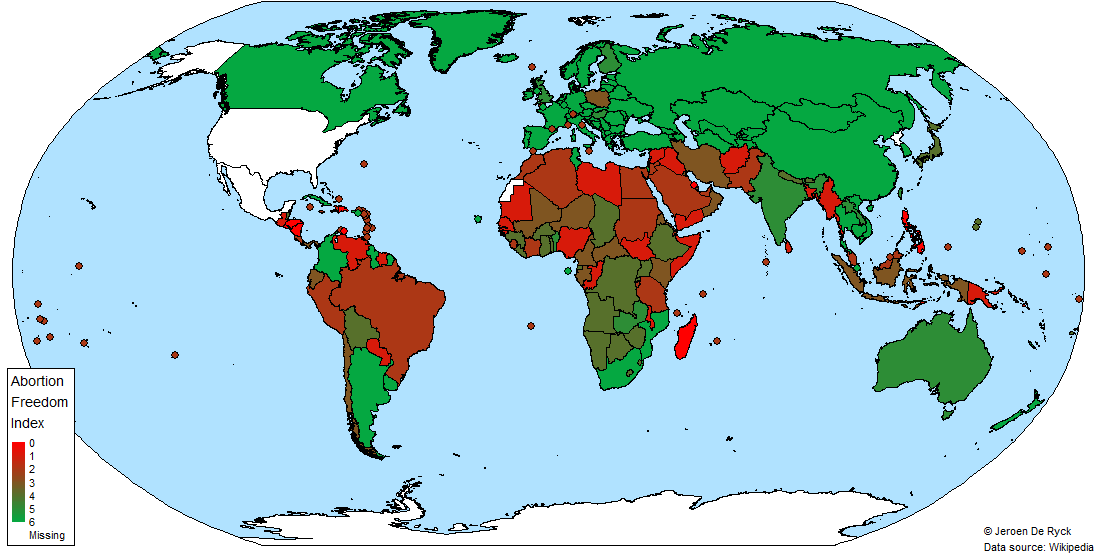
World map of Abortion Freedom Index
Europe scores very high on this index, with some exceptions like the micr-nations and Poland. The Far East does as well, with the exception of Myanmar and Bangladesh. The islands in the Indo-Pacific Region score a bit less. The AFI varies a lot in Africa, but tends to be higher as you go South. South America is very complex, with Venezuela scoring very low, but next-door neighbour Colombia scoring very high. All nations in the Carribean, which I haven’t mentioned before, score mediocre.
Improvements
There’s a lot that can be improved in these maps. It was the first time I’ve done such a thing, so it’s natural that I’ve learned a lot. (Edit: I actually did improve the Abortion Freedom Index. You can read about that here.)
A first thing I learned was that legislation is organized in a difficult way. Whilst most countries have it organized at a federal level, several (like the UK and US) have it organized at a national level. In some countries, the Overseas regions legislate things themselves, whilst others don’t. All this made mapping very difficult. I used a dataset with many countries and some subregions, but it didn’t match 1:1 with the Wikipedia article.
Second, I should have used a more thrustworthy source than Wikipedia. The latest UN data is from 2019. The Wikipedia supposedly uses that, as well as updates for some areas.
Another thing I could have done was taken the gestational age limit into count everywhere. The most restrictive gestational age limit is 5 weeks, which applies to abortion on request in Turkmenistan. According to this study, the mean gestational age at which mothers find out they’re pregnant is 5.5 weeks, so even if you immediately say you don’t want to have the child, more than half of mothers’ fetus is already too old to be eligible for abortion. That surely isn’t as free as countries where there is no or a very high limit. However, what do you do with the countries where such age is not specified. Leaving them out seems the straightforward option, but it left us with only 41 countries.
One could argue that abortion when the life of the mother is at risk is not the same as abortion for socioeconomic reasons or on request and should be weighed differently.
Methodology
First, I downloaded the Wikipedia page on Abortion Law. I did this on June 28th 2022 at 22:15 CEST. Any changes that happened after that are therefore not included in here. I manually made an Excel sheet out of this table. This wasn’t as easy as I had hoped.
For one, there were regions that are in the shapefile that are not mentioned separately on the Wikipedia page and the other way around. Some countries have recently changed their name, like how Ivory Coast became Côte d’Ivoire, Turkey became Türkiye and Swaziland became eSwatini.
But there are also some exceptions. Not all countries simply allow it up to a certain age. Then there are Ireland and Italy, where abortion in several circumstance is listed as “viable”, with a footnote saying “ If the risk to life or health is immediate, no gestational limit is specified.” I have simply interpreted that as “Permitted” with no limit. In Pakistan, abortion is allowed if there is a risk to health until organs are formed. This is also interpreted as “Permitted”, without setting a limit. A final note is that Vatican City is not on the map, and is also not included in the statistics, but they do have abortion legislation. If you’re interested in that, here’s the Wikipedia snippet:
However, in accordance with the principle of double effect, in the rare cases of indirect abortion, such as when, in an ectopic pregnancy, the fallopian tube is removed, or in cases of ovarian cancer. In these cases the procedure is aimed only at preserving the woman’s life, and the death of the fetus, although foreseen, is not willed either as an end or as a means for obtaining the intended effect.
For the map, I used a shapefile that includes 252 countries/regions that was available for free on the internet. Source: Shape downloaded from http://www.efrainmaps.es. Carlos Efraín Porto Tapiquén. Geografía, SIG y Cartografía Digital. Valencia, Spain, 2020. There are however still regions on the list that are not on the map. This mostly concerns breakaway nations like Abkhazia, the Donetsk People’s Republic and some others.
I portrayed the small islands seperately, by filtering for countries that are smaller than 5000 km², are not part of France or Norway and have data. I created a seperate layer portraying this data with bubbles.
Where graphs are shown, only countries are taken into count. All regions that are part of another country in one way or another are left out. The selection was based on the inclusion of another country between brackets in the name of polygon in the map data. E.g. “Guernsey (UK)” is part of the UK (although technically it isn’t), so it’s left out. Western Sahara and Antarctica, however are left in. As there are no statistics for either, I could have simply left them out.
#=================
# INSTALL PACKAGES
#=================
library(tidyverse)
library(rvest)
library(magrittr)
library(ggmap)
library(stringr)
library(tmap)
library(tmaptools)
library(sf)
library(ggplot2)
library(rnaturalearth)
library(readxl)#Fetch geojson from here: https://www.michaelminn.net/tutorials/r-projections/2022-world-data.geojson
countries = read_sf("Shapefile/World_Countries.shp")
setwd("G:/My Drive/Projects/Creative/Blog")
Abortion = read_excel("Abortion/Abortion.xlsx")countries_temp <- countries %>%
st_set_geometry(NULL) %>%
arrange(COUNTRY) %>%
write.table("countries.txt", append = FALSE, sep = " ", dec = ".", row.names = FALSE, col.names = FALSE, quote = FALSE)
``````{r, fig.width=12, figh.width=9}
#Transform to the Robinson projection
robinson = "+proj=robin +lon_0=0 +x_0=0 +y_0=0 +datum=WGS84 +units=m +no_defs"
projected = st_transform(countries, robinson)data <- projected %>%
left_join(Abortion, by = c("COUNTRY" = "Country"))#Bubbles for little countries
small_countries <- data %>%
mutate(area = st_area(geometry)/1000000) %>%
filter(area < units::set_units(5000, m^2) ) %>%
filter(!grepl('(France)', COUNTRY)) %>%
drop_na(RiskLife) %>%
st_as_sf()#World map of the legality of abortion when the life of the mother is at risk
tm_shape(data) + tm_polygons(col = "RiskLife", title="Abortion legality when\nlife is at risk", palette = c("#05a841", "green", "red", "orange", "yellow", "gray"), legend.text.size = 2) + tm_style("natural") + tm_layout(legend.bg.color = "white", legend.position = c("left", "bottom")) + tm_credits("© Jeroen De Ryck\nData source: Wikipedia", position = c("RIGHT", "BOTTOM"), bg.color="white", col="black") + tmap_mode("plot") + tm_shape(small_countries) + tm_bubbles(col = "RiskLife", scale=0.55, legend.col.show = F, palette = c("#05a841", "green", "orange"))#World map of the legality of abortion when the health of the mother is at risk
tm_shape(data) + tm_polygons(col = "RiskHealth", title="Abortion legality when\nhealth is at risk", palette = c("#05a841", "green", "red", "orange", "yellow", "gray"), legend.text.size = 2) + tm_style("natural") + tm_layout(legend.bg.color = "white", legend.position = c("left", "bottom")) + tm_credits("© Jeroen De Ryck\nData source: Wikipedia", position = c("RIGHT", "BOTTOM"), bg.color="white", col="black") + tmap_mode("plot") + tm_shape(small_countries) + tm_bubbles(col = "RiskHealth", scale=0.55, legend.col.show = F, palette = c("#05a841", "green", "red", "orange"))#World map of the legality of abortion when the pregnancy was caused by rape
tm_shape(data) + tm_polygons(col = "Rape", title="Abortion legality when\npregnant by rape", palette = c("#05a841", "green", "red", "orange", "yellow", "gray"), legend.text.size = 2) + tm_style("natural") + tm_layout(legend.bg.color = "white", legend.position = c("left", "bottom")) + tm_credits("© Jeroen De Ryck\nData source: Wikipedia", position = c("RIGHT", "BOTTOM"), bg.color="white", col="black") + tmap_mode("plot") + tm_shape(small_countries) + tm_bubbles(col = "Rape", scale=0.55, legend.col.show = F, palette = c("#05a841", "green", "red", "orange"))#World map of the legality of abortion when there would be birth defects
tm_shape(data) + tm_polygons(col = "FetalImp", title="Abortion legality for\nfetal impairment", palette = c("#05a841", "green", "red", "orange", "yellow", "gray"), legend.text.size = 2) + tm_style("natural") + tm_layout(legend.bg.color = "white", legend.position = c("left", "bottom")) + tm_credits("© Jeroen De Ryck\nData source: Wikipedia", position = c("RIGHT", "BOTTOM"), bg.color="white", col="black") + tmap_mode("plot") + tm_shape(small_countries) + tm_bubbles(col = "FetalImp", scale=0.55, legend.col.show = F, palette = c("#05a841", "green", "red", "orange", "yellow"))#World map of the legality of abortion for socioeconomic reasons
tm_shape(data) + tm_polygons(col = "SocioEcon", title="Abortion legality for\nsocioeconomic reasons", palette = c("#05a841", "green", "red", "orange", "yellow", "gray"), legend.text.size = 2) + tm_style("natural") + tm_layout(legend.bg.color = "white", legend.position = c("left", "bottom")) + tm_credits("© Jeroen De Ryck\nData source: Wikipedia", position = c("RIGHT", "BOTTOM"), bg.color="white", col="black") + tmap_mode("plot") + tm_shape(small_countries) + tm_bubbles(col = "SocioEcon", scale=0.55, legend.col.show = F, palette = c("#05a841", "green", "red", "orange", "yellow"))#World map of the legality of abortion for socioeconomic reasons
tm_shape(data) + tm_polygons(col = "Req", title="Abortion legality on request", palette = c("#05a841", "green", "red", "orange", "yellow", "gray"), legend.text.size = 2) + tm_style("natural") + tm_layout(legend.bg.color = "white", legend.position = c("left", "bottom")) + tm_credits("© Jeroen De Ryck\nData source: Wikipedia", position = c("RIGHT", "BOTTOM"), bg.color="white", col="black") + tmap_mode("plot") + tm_shape(small_countries) + tm_bubbles(col = "Req", scale=0.55, legend.col.show = F, palette = c("#05a841", "green", "red", "orange", "yellow"))#World map of self-constructed Abortion Freedom Index
tm_shape(data) + tm_polygons(col = "AFI", title="Abortion\nFreedom\nIndex ", palette = c("red", "#05a841"), style = "cont", legend.text.size = 2) + tm_style("natural") + tm_layout(legend.bg.color = "white", legend.position = c("left", "bottom")) + tm_credits("© Jeroen De Ryck\nData source: Wikipedia", position = c("RIGHT", "BOTTOM"), bg.color="white", col="black") + tmap_mode("plot") + tm_shape(small_countries) + tm_bubbles(col = "Req", scale=0.55, legend.col.show = F, palette = c("#05a841", "red"))
Recommend
About Joyk
Aggregate valuable and interesting links.
Joyk means Joy of geeK